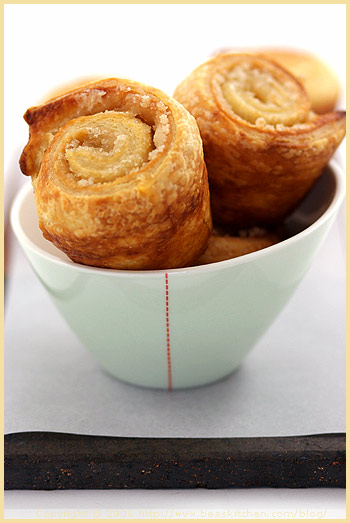
“Quelle heure il est ? Tu es déjà en train de cuisiner ? What can I smell?”, P. asked coming down the stairs (What time is it? You are already cooking?) Well, yes I was, but it was easy. And I think we both liked the idea so early on Sunday morning.
Mornings that can be spent feeling lazy, taking the time that we miss to do little things otherwise rushed. Not thinking much about what time it is, or worrying about having to be somewhere at a certain time. The Sundays I like have this taste. They even get better when a fragrant sugary scent makes the whole house smell like a sugar bun. At home, it happens only if I am in the kitchen, but I can always dream that maybe one day, a fairy will start cooking in my own kitchen. Or I could think of casting a spell on P. so that he starts as well. I wish this sometimes, even if I know that if I were to be deprived of cooking, I would become a grumpy little Frenchie. P. reports that he is not keen on getting to this part, so he lets me cook, and I can still hope for the fairy to come.

My breakfasts are pretty large. And they are not typically French. Croissants ? Petit noir* ? Non, pas moi (Not me). I must have origins rooted in the Northern parts of Europe (even if I know that my mum’s family comes fom Austrian shepherds). Fromage, poisson fumé, jambon, all for me! Le p’tit déj (short for Le petit déjeuner, ie breakfast) usually includes a freshly squeezed juice of some kind, orange or apple, with cereals or granola which I learned to eat in the US. Slices of pain complet (Whole grain bread) are a must but I also love fresh baguettes au levain. While traveling to Iceland, I liked to eat smoked fish, in Italy, I noticed a lof of sweet food, in Turkey, salty cheese with cucumber and tomatoes. In France, as odd as it seems, I actually rarely start my day with viennoiseries or a croissant. I prefer to nibble on those during the day, as an afternoon snack. But there are exceptions.
*Un petit noir (literally a small black) is a term used to mean espresso (un café is by default an espresso in France). You pronounce it “p’tit noir”.

The beautiful red foliage of New England.
After making a batch of croissant dough last week, I divided the dough in two halves. The first half was used to bake croissants, the second one to prepare these Morning Sugar Rolls. And I am so glad I waited for those!
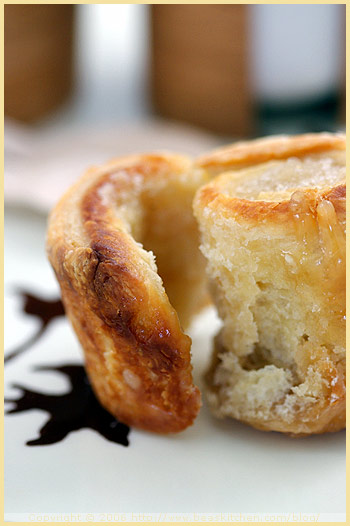
Once you have gone through the trouble of making the croissant dough, nothing is difficult in the last part required to make these sweet viennoiseries. All you need is a little rolling, one-night wait in the fridge, one hour for the dough to proof again at room temperature before the last 20 mns in the oven in the next morning. True, this requires some time and organization, and some patience for sure, so maybe the dream of a little fairy helping with some steps would be ideal. But even without one, it is worth the try. The sugar rolls had a moist flaky dough inside, were crispy on the outside, and offered a delicate touch of vanilla sugar in the middle. Truly delicious! In fact, after eating one, I knew right away that I preferred the croissant dough cooked in those sugar rolls to the croissants made before. And that is saying a lot. As much as I do not often eat sweet breads in the morning, in this case, there was little I could do to resist. They were that good. Even my friend J. stole a few for his breakfast the next day. I must like J. quite a lot for having accepted his request!

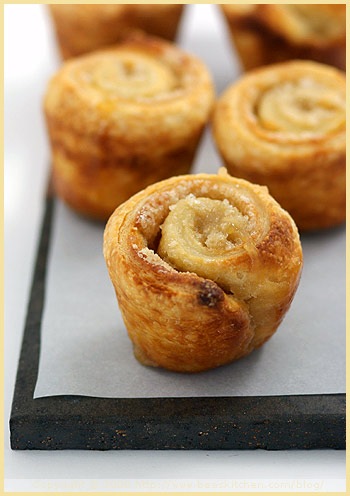
(Recipe from Leslie Mackie’s lovely Macrina Bakery and Café Cookbook)
You need:
- Croissant dough see here, half the batch gives 6 rolls.
- 3/4 cup granulated sugar
- 2 + 1/4 tsp pure vanilla extract
- Spray bottle
Steps:
- Follow all of the steps from here until the last one indicating form croissants.
You will prepare your rolls the day before, to be cooked the following day. - Mix together the sugar with the vanilla extract, until all of the liquid is absorbed.
- Take the dough out of the fridge and roll it into a rectangle, about 12 x 20″.
- Mist it with water from the spray bottle.
- Cover with the sugar mixture and roll it into a log.
- Cut 6 equal rolls and place them into oiled muffin pans. Cover with plastic wrap and let proof in a warm room for 1 hour (min 70 F) before placing them in the fridge for 8 hours min, or overnight.
- The next morning, take the rolls out of the fridge and let rest at room temperature for 1 hour. Then preheat your oven at 385 F and cook the rolld for about 20 min (the cookbook recipe says 40 to 45 mns but I think this is way too long, I checked after 20 mns and it was fine with me). Do not let the rolls cool down in the pan as they will stick because of the sugar.

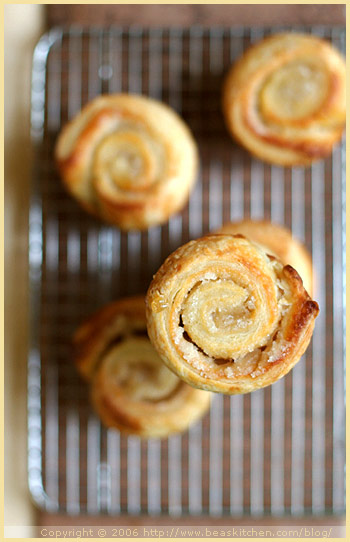
(Recette tirée du livre Macrina Bakery and Café Cookbook)
Ingrédients :
- Pâte à croissant voir ici, la moitié de la fournée donne 6 roulés.
- 150 g de sucre de canne fin
- 2 + 1/4 càc d’extrait de vanille pur
- Vaporisateur
Étapes :
- Suivez les étapes de la recette ici jusqu’à l’indication Pour donner forme aux croissants.
Vous préparerez vos roulés la veille, pour les cuire le jour suivant. - Mélangez le sucre avec l’extrait de vanille.
- Sortez la pâte du frigo et étalez-la en un rectangle mesurant environ 30 x 50 cm.
- Mouillez-le en vaporisant de l’eau sur toute la surface.
- Recouvrez avec le mélange de sucre et roulez la pâte comme une bûche.
- Coupez 6 roulés de taille égale et mettez-les dans des moules à muffins huilés. Couvrez avec du film alimentaire et laissez lever dans une pièce chaude (min 20 C) pendant 1 heure avant de mettre au frigo pendant 8 heures minimum, ou pendant toute la nuit.
- Le lendemain matin, sortez vos roulés du frigo et laissez-les reposer 1 heure à température ambiante. Puis, préchauffez votre four à 190 C et cuisez les roulés pendant 20 mns environ (la recette indique 40 à 45 mns mais je pense que c’est bien trop long, j’ai vérifié après 20 mns et pour moi, ils étaient cuits). Ne les laissez pas refroidir dans les moules car le sucre va durcir et ils risqueraient de coller.

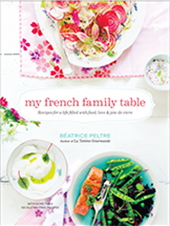
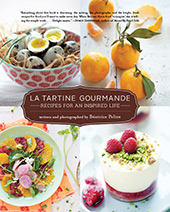
gorgeous and delicious photos as usual!
trop incroyables ces petits roules….
Those look so delicious! Love the photos!
The photos are really great! I definitely have to get my lazy but back to experiencing with pate feuilletée :-)))
Magiques! Tout est si incroyable chez toi 🙂 J’ adorerais, moi aussi, un dimanche matin, descendre lourdement l’ escalier, la tête encore pleine de rêves, et sentir une délicieuse odeur de viennoiserie,…euh…je rêve là!!Ca sert à rien de se faire du mal !!
Bea, je ne sais pas si c’est ton retour dans la maison familiale quelques jours qui t’a réussi, mais tu n’arrêtes pas et c’est toujours incroyablement beau!!
Je ne sais plus quoi dire sur la qualité de tes photos, je suis hypnotisée..
Pour en revenir à la pâte à croissant, si un jour il te prenait l’envie d’en refaire, choisi une recette française!! Te viendrait-il en tête d’aller chercher une recette de pumpkin pie dans un livre russe ou grec..;))
En général, on compte en base moitié de beurre par rapport à la farine..
Pour le petit déjeuner de ce matin, c’est un peu tard mais pour demain matin, oh oui, j’en veux !
It’s the croissant dough that’s the problem! I’ll just take some of yours please.
In the summer time, when my wife is off from teaching, the “Make the bed” Fairy comes to our house as well as “The clean clothes washed and put away” Fairy *grin* For the record, I’m the troll (I’m so not built like a fairy) who does these tasks normally
Oh my !!!!! J’ai justement un café dans la main là, et même si ce n’est plus vraiment le matin j’en croquerais bien 1 ou 2 (ou 3) !
The morning rolls look fantastic and your pictures of the New England Fall are great too.
Ils sont magnifiques et moi aussi j’aimerais bien qu’ils apparaissent comme par magie dans ma cuisine demain matin.
A très bientôt.
voilà de quoi je vais rêver toute la nuit, croisant les doigts pour trouver ces merveilles près de moi au réveil… sait on jamais? 😉
Wonderful! I think you are as in love with the Macrina cookbook as I am now! You MUST try the cream scone recipe… I think it’s called Current & Anise scones or some such, but I always tend to use fresh berries. They are the lightest most incredible scones you will have tasted. I’m about to do a post on them on my blog… one I’ve been meaning to do now for a month but each time I make a batch, we eat them before I have a chance to shoot them! Four batches later, I finally took photographs!
I LOVE the last photo in particular (though all are beautiful!)
-L
C’est sublime !
Tes photos sont de plus en plus belles ! Et le petit dej salé c’est plaisant aussi !
Ton blog ne m’est plus inconnu depuis peu, superbes photos et belles idées.
Ces petits rouleaux sont très tentants pour un petit déj…
These look so beautiful and delicious! I will have to make them. And oh, how I love those red leaves.
Yum! Yes, I yearn for a good fairy too!
Delicious! I think I’d be happier with this as an afternoon snack though, as my mouth doesn’t deal well with sweet/rich things in the morning 🙁
Je ne sais pas ce que j’aime le plus, les petits roules ou tes superbes photos de New Engand. Magnifique!
Lovely! The last photo is wonderful!
Bonjour,
mes compliments, cette recette (et ça photo) est vraiment très belle, à noter!
Je viens de petit dejeuner d’une magnifique brioche chez Papilles et Pupilles, mais je prendrais bien encore un de ces petits roules. Je connais tout plein de sucres parfumes qui iraient bien avec ca, si seulement je prenais le temps de me mettre a la pate feuilletee. J’adore ta photo des feuillages rouges.
I agree, the scene in New England during the time of this year is breath-taking! And so is your photos! I’d like to have these rolls a few times a day with my coffee.
You take beautiful photos! I guess it also helps that you bake beautiful goodies too 🙂 Those look lovely and I would love to have them for breakfast. Do you just stick the other half of the dough in the freezer? And how long do you allow for thawing when you are going to use it?
i won’t take a chance just yet with croissants, but i will try this sugar roll with plain dough! still sounds good to me! and again, love love those vibrant red foliage!
J’adore ces petites patisseries !!!
The rolls look scrumptious, of course, but I really love that shot of the red leaves – what I’m missing out on in California!
thank you Kat
Veronica, merci
Nicole, thanks again.
Sigrid, yes I am sure you would do “des merveilles” with it.
Ellie, merci beaucoup, oui j’ai le meme reve! 😉
Sandra, merci, tu es bien gentille. Et ton commentaire me fait bien rire, tu as raison de faire cette comparaison, je ne sais pas ou j’avais la tete et je te promets, j’essayerai une recette bien de chez nous!
Sophie, mais que oui!
Brylinn, ahah, don’t be afraid of it!
Jeff, ahah, lucky you!
Framboise, mais dis-moi, on n’appelerait pas cela de la gourmandise?
Peabody, thank you, glad you like them.
Pascale, merci et comme tu le dis, c’est une bien bonne idee. Je reve de cela moi aussi! Peut-etre un jour!
Alhya, j’espere que ta nuit aura ete fructueuse dis moi, Si on s’y met tous, peut-etre que la-haut on va nous entendre.
L, thank you. You are right, the book is a MUST! I saw your scones and they look delicious, and are on my list!
Karine, merci.
Fabienne, merci a toi, bien trop sympa! Ah oui, le sale le matin, c’est mon dada!
Annellenor, merci et bienvenue! Ravie que cela te plaise.
Danielle, thanks! I am sure you will love them. They were delicious.
Bron, maybe if you and I think very strongly together, it will show up!
Ellie, afternoon snack is good too, I like them then as a matter of fact.
Helen, merci! C’est vrai que la Nouvelle-Angleterre en ce moment, c;est magique.
Emma, thank you!
Lory, merci.
Gracianne, ah tu me tentes la avec les sucres dont tu parles. Il faut que tu viennes vraiment voir ces feuilles ici en automne, elles sont vraiment incroyables et c’est bien particulier a la Nouvelle-Angleterre.
Gattina, thank you. Yes true, pure beauty in nature here in the fall.
Joey, thank you. I actually did not freeze the other half but used it almost right away, so I am afraid I would not know.
Ces, thank you!
Mystery rose, merci beaucoup.
Anita, thanks. Yes the leaves are gorgeous here. New England has always been known for this and you know what? It is no myth!
I ha en’t even had amoment to make the croissants and you’ve posted another great pastry.
Superbe billet Béa!
L’automne vu de ton appareil est vraiment magnifique, comme cette recette 🙂
A bientôt
Hi Bea,
I am drooling. It looks like a serious project, but worth every minute and calorie 🙂
Cheers,
-Helen
Mmmmmm … I can smell how good they are from here!
Sugar high~~ Lolz…these rolls look absolutely beautiful and delicious! You’re fantastis, Bea.
oh yummy! i wish croissant dough wasn’t so hard to make 🙁
Thanks for posting this. I used to live in the same building that Macrina is in and these were my favorites. I’ve made them once a couple of years ago and they were amazing! The croissant dough is a lot of work. I’m making them again for my husband’s b-day.
Is this correct, you proof the product and then place in fridge overnight?
Seems a little opposite of usual practice.
Pingback: morning buns – Cannella Vita